The chessboard can come with or without coordinates. For most beginners, boards with coordinates make remembering where their pieces are a bit easier.
Chess boards are usually 8 squares by 8 squares with dark and light squares alternated.
A chessboard has 64 squares (8 x 8 layout), 32 black squares, and 32 white squares.
Similarly, a chess set consists of 32 pieces.
There are 16 white pieces and 16 black pieces.
There are eight pawns, two knights, two bishops, one queen, and one king on each side.
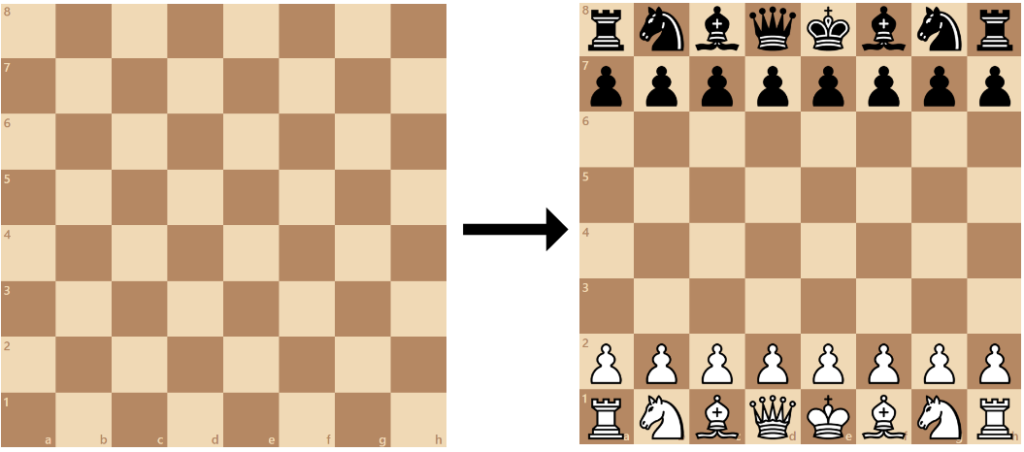
Black pieces are always placed on the seventh and eighth ranks, while white pieces are always on the first and second ranks. Simple and straightforward!
Between the two players, place the board. A light color should be used in the lower right-hand corner. Otherwise, rotate the board.
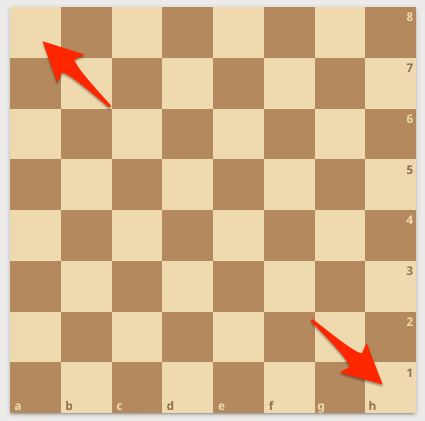
The rule here is that your right-hand corner must have a light-colored square, as highlighted in yellow.
Identifying the Pieces
Table of Contents
Chess pieces come in six different variations. These include:
- King
- Rook
- Bishop
- Queen
- Knight
- Pawn
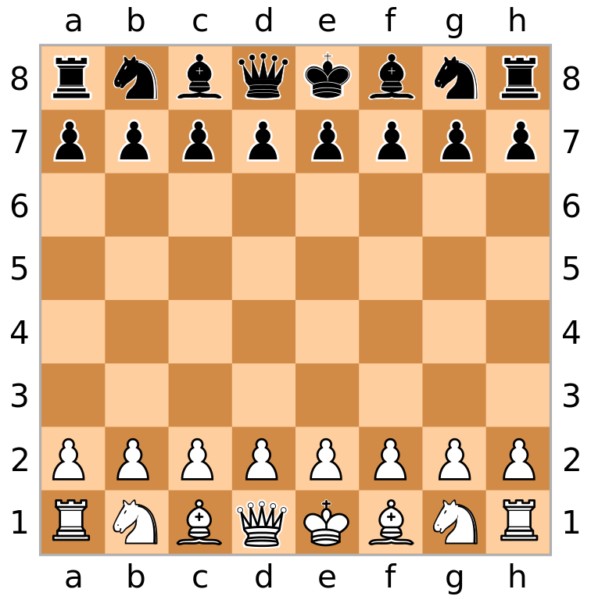
The King
A king is a piece at the top with a cross.
King pieces start on squares e1 and e8.
White kings should be placed on dark squares, while black king placed on light squares.
If the e1 square is white, then you will need to rotate the board so the e1 square is dark.
King moves one square in any direction.
A king cannot jump over other pieces, so at the beginning of a chess game, it cannot make any moves since it is enclosed by others.
The Rook
The rook resembles a castle.
Two rooks are placed in each corner of the board on each side.
There is no limit to the number of squares the rook can move up, down, and across.
Since it cannot jump over other pieces, it cannot move at the beginning of the game.
The queen is the only piece stronger than this piece, also known as a major piece.
The Bishop
In chess, the bishop is considered a minor piece because it is not as strong as the rook.
But it still has a considerable amount of mobility and can be used in pairs.
As a start, you have two bishops.
The king and queen are located right next to them.
The light squares will have one bishop and the dark squares will have one bishop.
The squares will always be the same color throughout the game.
Bishops can move diagonally as many times as they want without jumping over other pieces.
The Queen
The queen is represented by the crown on top.
The combined moves of a rook and a bishop make this the most powerful chess piece.
The queen is a major prominent piece in chess.
Queens are placed on squares d1 and d8.
The color of the square should match the queen’s color.
It is necessary to rotate the board so that the d1 square is a light-colored square if you see the d1 square as a dark square.
The chess game relies heavily on how you use the queen correctly.
Queen draws on the actions of both bishop and rook.
The Queen can be moved diagonally or up, down, or sideways as many times without stepping over another piece.
The Knight
Knights are pieces that resemble horses.
The piece has a very unique movement which makes it difficult to describe.
For its own reasons, it is regarded as strong as a bishop.
Initially, you have two knights.
In white, you will have them on squares b1/g1 and in black, they will be on squares b8/g8.
Only the knight can jump over another piece on the board.
Knights move in an L-shaped pattern.
The knight will still be able to move the same number of squares even if it is surrounded by material.
The Pawn
Chess has eight pawns, and each player starts with eight of them.
It is placed on either side of the board on the second row from the bottom of each side.
Despite being the weakest piece on the board, the pawn plays an important role in the game.
Chess pieces can only move in one direction on the board, the pawn.
Additionally, it is the only piece in the entire game that can’t be moved the same number of squares.
There is no turning back for a pawn. The first move allows you to move 1 or 2 squares.
For the remainder of the game, a pawn may only move forward one square.
Setting up the Chess Board
Bestselling Chess Board on Amazon
Placing the Pawns
First, pawns should be placed before higher-ranking chessmen. In a battle, they will be the first to respond before the higher-ups show up.
There are 8 of them in your set, and they’re usually the smallest pieces. The boxes are placed in a straight line on the second rank or row.
Player 1: The pawns should be placed vertically across the board with a “2” in the middle, from A-H.
Player 2: The pawns go on the vertical row “7” and the horizontal rows A-H.
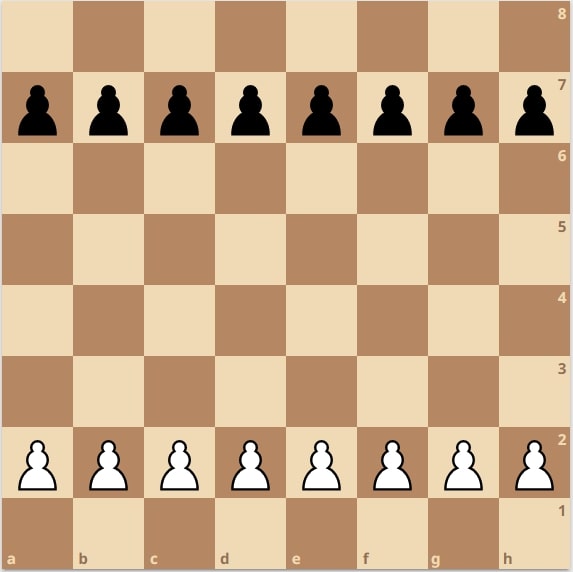
All of your eight pawns should be on the second row, known as the ranks.
Additionally, by doing this you will be able to clear up your pile of pieces so that you can sort through them more easily in the next steps.
The Rooks
The chess board is initially set up with four rooks at the four corners of the board
Here is a picture of how rooks can be arranged.
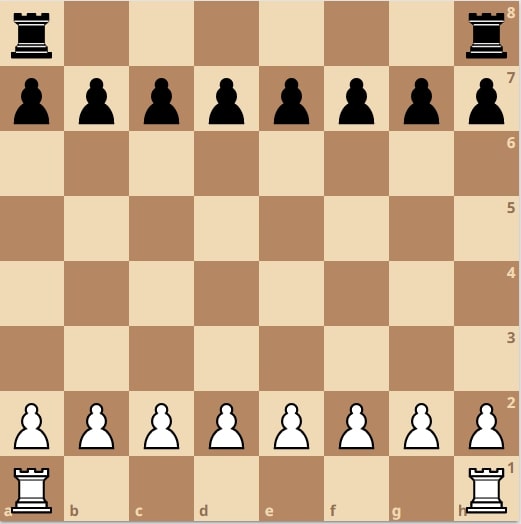
Here are the placements of the rooks: H1, A1, H8, A8.
The Knights
To arrange your knights in chess set up, simply place each one next to the rook in the first row.
Seeing how Knights are placed in the chess diagram can help you decide where to place them before starting a game.
For Knights, however, the squares would be B8, G8, B1, G1.
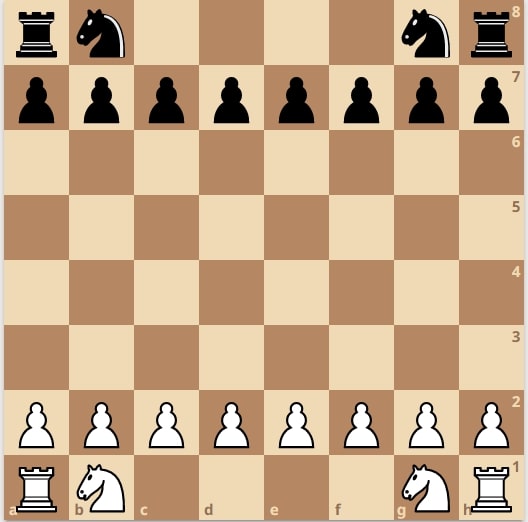
The Bishops
The image below illustrates where bishops are positioned at the beginning.
The bishops are positioned next to the knights.
There are four bishops on the following squares: c1, f1, c8 & f8 in chess notation.
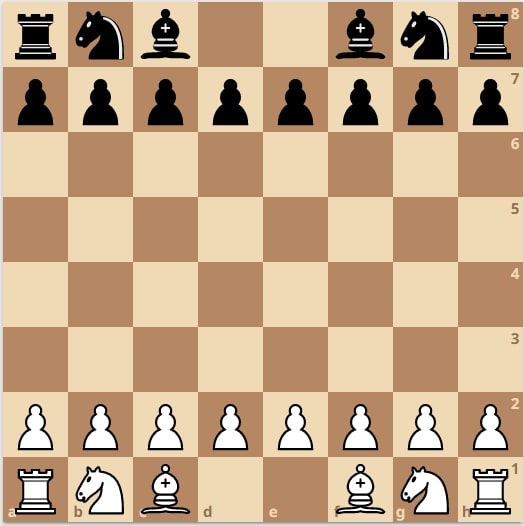
The Queen
At any given time, this is the most powerful and important chess piece on the board.
Each player is given one. This is also the piece most likely to be misplaced.
Position the queen on 1D for player 1
Position the queen on 8D for player 2
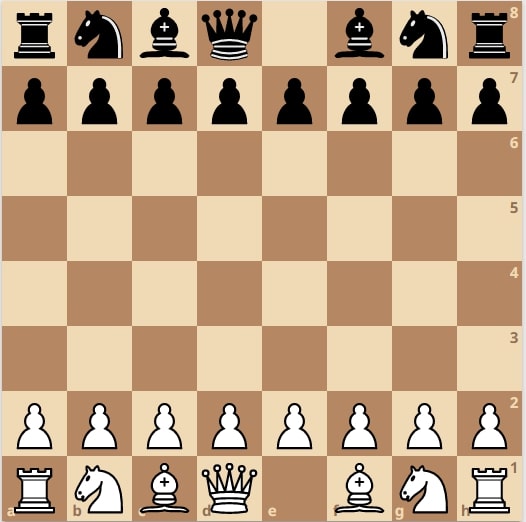
Consider that the queen has to match the color of the square to remember where she goes without relying on labels.
In other words, the black queen goes on the black square, while the white queen goes on the white square.
The King
A king goes on the last square left on the board, the last piece to be put on the board.
When his queen is right beside him in her rightful place as well, it’s easy to put him in his rightful place.
A lot of protection is needed for this piece. Game over once the opposing player captures or traps one of the kings.
To fully protect the single king piece from capture and entrapment, each player keeps theirs in the center of all pieces.
King is placed on square 1E by player 1
King is placed on square 8E by player 2
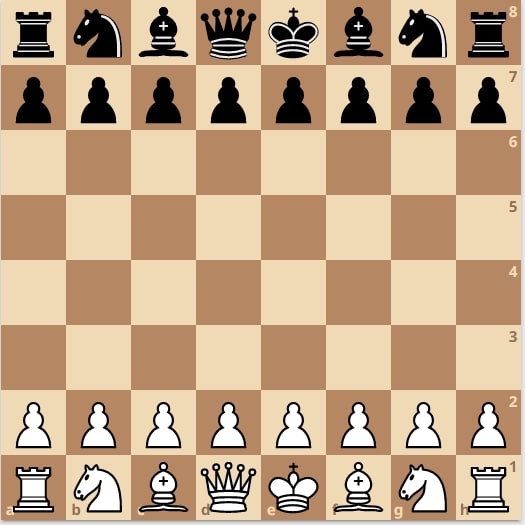
Set up your side, then check out how your opponent set up their chess board.
If all the pieces are in the right place, they should perfectly mirror each other.
There may have been a misplaced piece among you if they are not mirroring each other.
Players commonly misplace the king and queen, which can cause delays and distractions.
It is important to memorize where each piece goes on the board and to practice setting them up until it is second nature.
Following the setup of the chess board, you must know these rules:
- In this piece, white (light-colored) goes first and then alternates turns with the other players.
- In a single turn, only one piece can move except in casting, when the king and rook both move at the same time.
- To capture any piece, you first remove the opponent’s piece from the chessboard and replace it with your own piece.
- In chess, you cannot skip a turn.
- In chess, you cannot take your own piece.
- Chess pieces can only be moved according to the rules. The king, for example, cannot move forward more than one step.
- As well as pawn promotion, there are also some important moves that you should know about like en passant.
- The game ends with a checkmate. The winning side is the one who checksmate the other. Those who get checkmated lose the game.
Common FAQs on Chess For Beginners
Who invented chess?
In the 8th century, India invented chess. Over the centuries, the piece was renamed and decorated to look like it came from the English court by the Arabs, Persians, and then medieval Europeans.
How many squares are there on a chessboard?
There are 204 squares on a chessboard. As a result, you must calculate the number of 1×1 squares, 2×2 squares, 3×3 squares, etc. that are on the board.
As a result, these are the square numbers: 64, 49, 36, 25, 16, 9, 4, 1 – adding up brings up 204 squares on the chessboard.
What is a stalemate in chess??
In Chess, a Stalemate is a type of Draw. If a game ends in a stalemate, neither side wins or loses.
In a game, a stalemate occurs when a player is neither in check nor can move.
How many pieces are in chess?
There are sixteen pieces in chess.
There are sixteen pieces on each playing board at the start of the game, including a King, a Queen, two Rooks, two Bishops, two Knights, and eight Pawns.
What is en passant in chess?
During the 15th century, the rule giving pawns their first move as a double-step was introduced, and this introduced the en passant capture.
In this way, a pawn cannot advance two squares to pass an enemy pawn without being captured.
Which of these chess pieces only moves diagonally?
The Bishop is the only one who moves diagonally in all directions
How does the king move in chess?
In each direction, the king moves by exactly one square. Castling, or moving the king with the king piece, is permitted only once in a game per player (see below).
Rooks can move horizontally or vertically any number of vacant squares. Additionally, they move when casting.
How does the queen move in chess?
It is possible for a Queen to move anywhere along with the board, vertically or horizontally, no matter how many squares are open.
While the Knight can go through any piece, the Queen cannot. The Queen can also cross diagonally across the board much like a Bishop.
How does the knight move in chess?
Knights move several squares each time they move. In addition to moving up or down one square vertically, it may also move up or down two squares vertically, as well as up or down one square horizontally.
As this movement looks like a capital “L”, it can be called an “L-shape.”
How to castle in chess?
Two pieces can only be moved in the same turn with this special move. It is believed that castles were invented around the 1500s to speed up play since they only use the king and rook (no other pieces).
Castling moves your king away from the action in the middle of the board! This makes checkmating your king more difficult!
Practicing and mastering
When you begin playing chess for the first time, it may be confusing where pieces go. It is very normal to feel overwhelmed when there are 64 squares on the board of equal size.
During their first few games, new chess players with labeled boards may make mistakes and be confused. Eventually, as you play chess and practice setting up your pieces correctly, it will become second nature to you.
You will eventually master the correct placement of the pieces without worrying if you feel lost with all the different pieces.
In order to play a chess game correctly, you must follow all the rules and correctly place all the chess pieces. Grandmasters were once novices, but through determined practice and continued study, they have been able to attain their current level of expertise.
Occasionally, you may lose a chessman, especially a queen, which is so easily misplaced despite being the most powerful piece in the game. In order to improve your performance in future games, it is important to learn from your mistakes.
- How To Start & Light a Propane Heater? (Step By Step Guide) - December 7, 2025
- Best Electric Scooter for Heavy Adults up to 330 LBS In USA - December 7, 2025
- Best Budget Gaming Chair Under $150 – Reviews & FAQ’s - December 7, 2025

